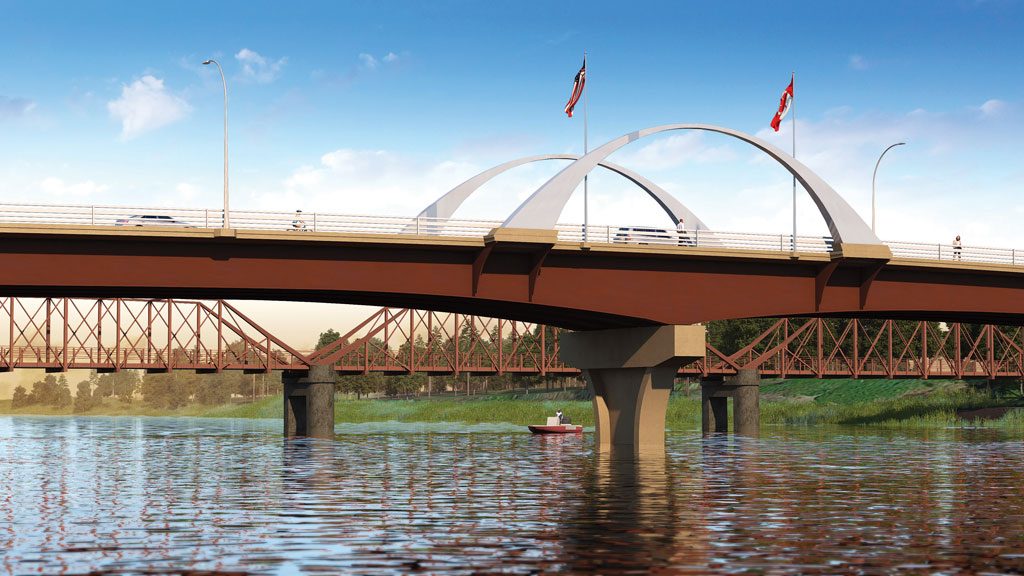Bridge construction is a complex undertaking at the best of times. When they cross international boundaries there is a whole new set of issues that have to be negotiated and navigated.
Certainly that is the case in the planning, design, and erection of the new US$40-million Baudette/Rainy River International Bridge which will cross the Rainy River between Baudette, Minn. and Rainy River, Ont.
It’s a project which has required close co-operation between the Ontario Ministry of Transportation (MTO) and the Minnesota Department of Transportation (MnDOT) including pre-construction clearance of design team members and construction workers. Such personnel were required to forward passports, birth certificates, and other appropriate documents to both U.S. Customs and Border Protection and the Canada Border Services Agency.
Construction workers are also required to check in at the appropriate Point of Entry facilities.
The new international bridge was designed by Minneapolis-based Parsons. The preliminary design consultant was Roseville, Minn.-based Stantec.
Being built by the Wisconsin-based Lunda Construction Company, the 411-metre-long, (1,348-foot) 14.675-metre-wide (47-foot) five-span steel girder (with a cast-in-place concrete deck) structure will replace the existing bridge. That structure was deemed a “fracture critical” bridge and targeted for replacement by Minnesota following the 2007 collapse of the I-35W bridge which killed 13 people and injured more than a 100.

Scheduled for completion by the fall of 2020, the new bridge is expected to increase commercial truck traffic and benefit the economies of communities on both sides of the border and along Highway 11 in northwestern Ontario. A restricted truss opening and the age/condition of the old bridge limits the amount and type of trucks which can use it, says Ontario Ministry of Transportation spokesperson Annemarie Piscopo.
Once the new bridge is open, oversize and overweight loads will be allowed into Canada with a MTO permit, she says.
In underscoring the numerous steps which had to be taken in the lead-up to the construction, she points out that even before the design was initiated, an agreement between Minnesota and Ontario had to be reached on issues such as scope of work, which authority would lead the design, how costs would be shared, and how payments would be made.
Although both consultants — Parsons and Stantec — are located in Minnesota, their companies have offices in Ontario and this will ensure that MTO’s specifications, policies and procedures are in place as well as ensuring compliance with the Canadian Highway Bridge Design Code, says Piscopo.
As both the state and the province are sharing the cost on an equal basis, the contract was advertised in both Minnesota and Ontario, “to allow bidders on both sides of the border the opportunity to bid the work.”
Selecting and awarding the contract was also a joint exercise.
The tendering followed the Minnesota Department of Transportation “Letting” process. Although different from MTO’s tendering process, it still follows the same principles for advertising and award.
In a series of co-sponsored, pre-bid meetings in Minneapolis to outline the Letting process to out-of-state contractors, the department conducted presentations on where to find the advertised contract, how to apply to MnDOT to have access to its electronic bidding system, and how to place a bid.
“The meetings were well attended by groups from both sides of the border,” says Piscopo, noting that a number of Canadian subcontractors have been hired to complete some of the work on the Canadian side of the bridge.
Work began in August 2018, with some embankment/approach work as well as a trial shaft to confirm the design assumptions for the four piers (two in the United States and two in Canada).
Designed with two 2.4-metre-deep (eight-foot) diameter drilled shafts with steel casings, the piers will be constructed first along with the approach embankment work, followed by erection of steel, and then the cast-in-place deck. The last piece of work will be the decommissioning and demolition of the old bridge, she says.
Constructed in the late 1950s and opened in 1960, the steel truss bridge was considered a heritage structure by the state of Minnesota. That was one of the complications for the Department of Transportation as it searched for solutions for its restoration or replacement, says district engineer J.T. (John) Anderson.
“We were under pressure. If one member failed, the whole bridge would fail,” says Anderson, noting it had no structural redundancy.
That Ontario did not consider the bridge a heritage structure made the decision to build a new bridge easier. Following two years of discussion and negotiation between the province and the state, preliminary design commenced in 2013, he says.
Although the project is only in its very early stages, to date it has progressed fairly smoothly. That can be partly attributed to the contractor prebid meetings where the construction details and border security requirements were explained in detail, says Anderson. “I’m glad we did that.”










Recent Comments
comments for this post are closed